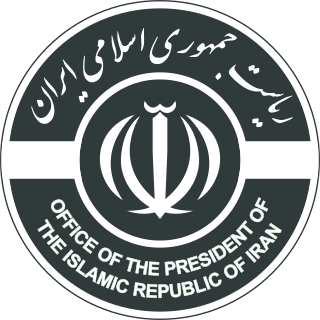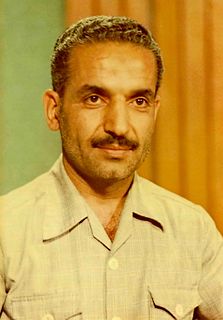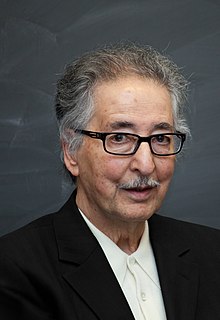| |||||
| Decades: | |||||
|---|---|---|---|---|---|
| See also: | Other events of 1981 Years in Iran | ||||
The following lists events that happened during 1981 in Iran.
| |||||
| Decades: | |||||
|---|---|---|---|---|---|
| See also: | Other events of 1981 Years in Iran | ||||
The following lists events that happened during 1981 in Iran.
By year's end, the government had announced a total of 1,656 executions before a firing squad. [10]

The president of Iran is the head of government of the Islamic Republic of Iran. The president is the highest-ranking official of Iran. The president carries out the decrees, and answers to the Supreme Leader of Iran, who functions as the country's head of state. Unlike the executive in other countries, the president of Iran does not have full control over the government, which is ultimately under the control of the Supreme Leader. Before elections the volunteers must be approved by the guardian council to become a president candidate. Those members of the guardian council are chosen by the supreme leader. The President of Iran is elected for a four-year term by direct vote and is not permitted to run for three consecutive terms.

Mohammad Hosseini Beheshti was an Iranian jurist, philosopher, cleric and politician who was known as the second person in the political hierarchy of Iran after the revolution. Beheshti is considered to have been the primary architect of Iran's post-revolution constitution, as well as the administrative structure of the Islamic Republic. Beheshti is also known to have selected and trained several prominent politicians in the Islamic Republic, such as current President Hassan Rouhani, former President Mohammad Khatami, Ali Akbar Velayati, Mohammad Javad Larijani, Ali Fallahian, and Mostafa Pourmohammadi. Beheshti also served as the Secretary General of the Islamic Republic Party, and was the head of the Iranian judicial system. He further served as Chairman of the Council of Islamic Revolution, and the Assembly of Experts. Beheshti earned a Ph.D. in Philosophy, and was fluent in English, German and Arabic.

Akbar Hashemi Rafsanjani was an Iranian politician, writer and one of the founding fathers of the Islamic Republic who was the fourth President of Iran from 3 August 1989 until 3 August 1997. He was the head of the Assembly of Experts from 2007 until 2011, when he decided not to nominate himself for the post. He was also the chairman of the Expediency Discernment Council.

Mohammad-Ali Rajai was the second President of Iran from 2 to 30 August 1981 after serving as prime minister under Abolhassan Banisadr. He was also minister of foreign affairs from 11 March 1981 to 15 August 1981, while he was prime minister. He was assassinated in a bombing on 30 August 1981 along with prime minister Mohammad-Javad Bahonar.

Sayyid Abolhassan Banisadr is an Iranian politician. He was the first President of Iran after the 1979 Iranian Revolution abolished the monarchy, serving from 4 February 1980 until he was impeached by parliament on 20 June 1981. Prior to his presidency, he was the minister of foreign affairs in the interim government. He has resided for many years in France where he co-founded the National Council of Resistance of Iran. At age 88, Banisadr is currently the oldest living former Iranian President.

Mohammad-Javad Bahonar was a Shia Iranian theologian and politician who served as the Prime Minister of Iran for less than one month in August 1981. Bahonar and other members of Mohammad-Ali Rajai's government were assassinated by Mujahideen-e Khalq.

Mir-Hossein Mousavi Khameneh is an Iranian reformist politician, artist and architect who served as the seventy-ninth and last Prime Minister of Iran from 1981 to 1989. He was a reformist candidate for the 2009 presidential election and eventually the leader of the opposition in the post-election unrest. Mousavi served as the president of the Iranian Academy of Arts until 2009, when Conservative authorities removed him.

The Prime Minister of Iran was a political post in Iran (Persia) that had existed during several different periods of time starting with the Qajar era until the end of the Pahlavi dynasty. It was also in existence from 1979 to 1989 following the Iranian Revolution, but was abolished in 1989.

Ayatollah Mohammad Reza Mahdavi Kani was an Iranian Shia cleric, writer and conservative and principlist politician who was Acting Prime Minister of Iran from 2 September until 29 October 1981. Before that, he was Minister of Interior and Minister of Justice in the cabinets of Mohammad-Ali Rajai and Mohammad-Javad Bahonar. He was the leader of Combatant Clergy Association and Chairman of the Assembly of Experts and also founder and president of Imam Sadiq University.

One of the most dramatic changes in government in Iran's history was seen with the 1979 Iranian Revolution where Shah Mohammad Reza Pahlavi was overthrown and replaced by Ayatollah Ruhollah Khomeini. The patriotic monarchy was replaced by an Islamic republic based on the principle of rule by Islamic jurists,, where clerics serve as head of state and in many powerful governmental roles. A pro-Western, pro-American foreign policy was exchanged for one of "neither east nor west", said to rest on the three "pillars" of mandatory veil (hijab) for women, and opposition to the United States and Israel. A rapidly modernizing capitalist economy was replaced by a populist and Islamic economy and culture.
The Council of the Islamic Revolution was a group formed by Ayatollah Ruhollah Khomeini to manage the Iranian Revolution on 10 January 1979, shortly before he returned to Iran. "Over the next few months there issued from the council hundreds of rulings and laws, dealing with everything from bank nationalization to nurses' salaries." Its existence was kept a secret during the early, less secure time of the revolution, and its members and the exact nature of what the council did remained undisclosed to the public until early 1980. Some of the council's members like Motahhari, Taleqani, Bahonar, Beheshti, Qarani died during Iran–Iraq War or were assassinated by the MKO during the consolidation of the Iranian Revolution. Most of those who remained were put aside by the regime.

This article is a timeline of events relevant to the Islamic Revolution in Iran. For earlier events refer to Pahlavi dynasty and for later ones refer to History of the Islamic Republic of Iran. This article doesn't include the reasons of the events and further information is available in Islamic revolution of Iran.
Premiership of Mir-Hossein Mousavi were the third and fourth government of Iran after the Iranian Revolution. At that time, Ali Khamenei was the president.

In August 1981, President Mohammad-Ali Rajai and Prime Minister Mohammad-Javad Bahonar were assassinated in an explosion. Ali Khamenei was then elected as the third president of Iran in the October 1981 Iranian presidential election. He put forward Ali Akbar Velayati as his prime minister, but the Iranian parliament did not give him the vote of confidence, and he was defeated with a vote of 80 to 74. Subsequently, Ali Khamenei, though he had strong disagreements with Mousavi, as a compromise with the left-leaning parliament, agreed to offer him, Mousavi, for the post of premier. On 28 October, the parliament approved Mousavi with a vote of 115 to 39. Mousavi became the 79th Prime Minister of Iran on 31 October 1981, and remained the prime minister of Iran until 3 August 1989, for eight years.
The Government of Mohammad-Javad Bahonar was the second government of Iran after the Iranian Revolution. During that time, Mohammad-Ali Rajai was president and Mohammad-Javad Bahonar was prime minister.

Government of Mohammad-Ali Rajai was the first government of Iran after the Iranian Revolution. At that time, Abolhassan Banisadr was president and Mohammad-Ali Rajai was prime minister.

Sayyid Mahmoud Kashani is an Iranian politician, academic, writer and lawyer. He is also a professor in Shahid Beheshti University. He was head of the Iranian delegation to the International Court of Justice in The Hague, Netherlands from 1981 to 1985. He was also a presidential candidate in the 1985 and 2001 elections.
Events from the year 1980 in Iran.